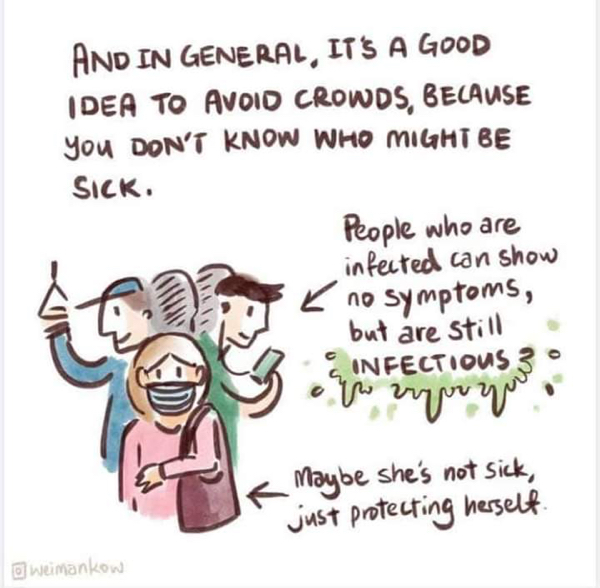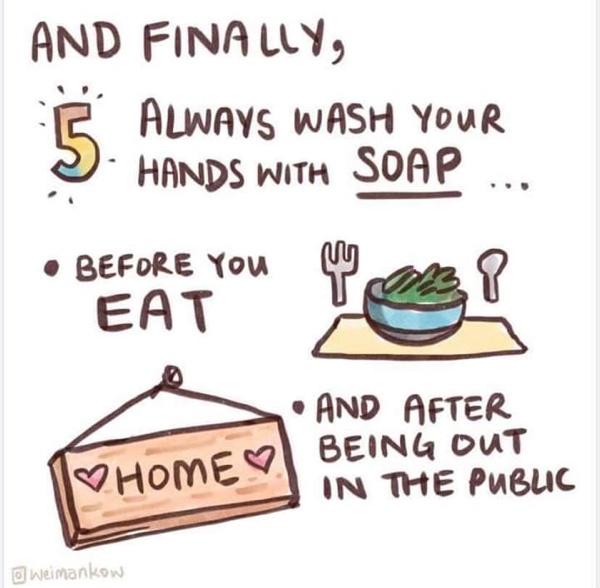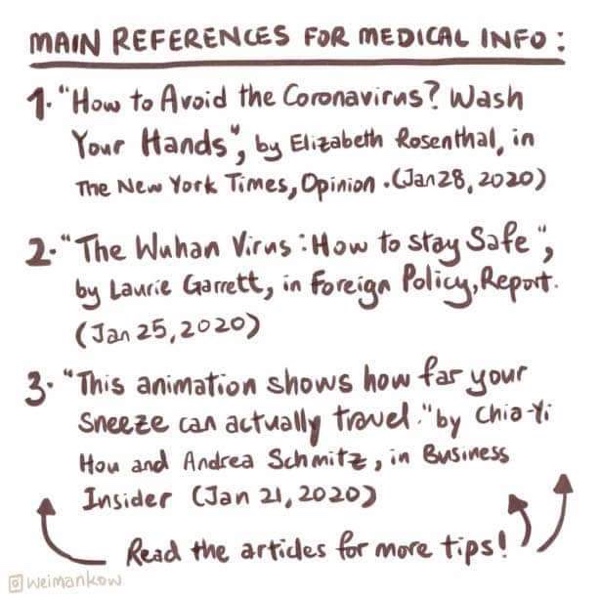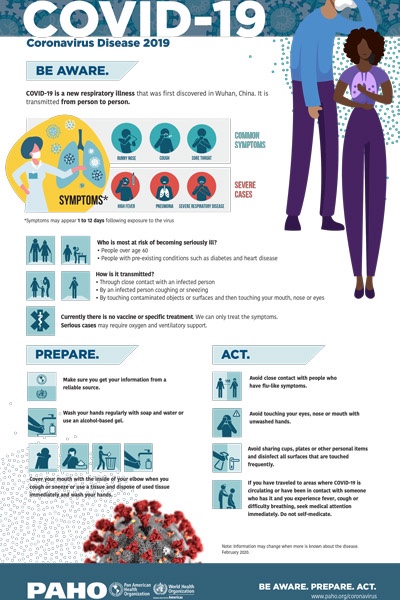
Hi, everyone. Here's a short primer on the COVID-19 virus, which I hope is helpful. Know that all of the information here is backstopped, and is sourced from factual sources. If you have more information to share, please do share in your own post.
What is COVID-19

COVID-19 is a virus, like the flu is a virus.
COVID-19 is also dangerous like the flu, but, unlike the flu, it's mainly dangerous because (1) it is contagious and there is no cure yet, and (2) people have no resistance to it and may die if infected.
That's because it's a new kind of coronavirus (coronaviruses are a large family of viruses that are common in both humans and animals): there are currently seven strains of human coronaviruses that have been identified. Four of these strains are very common and can be found almost everywhere. These common human coronaviruses typically cause a mild to moderate respiratory illness.
Sometimes, new coronaviruses emerge.
Last year, a new strain of human coronavirus emerged, and it was called COVID-19. Illnesses associated with this virus were first reported in the city of Wuhan, the capital of China's Hubei province, and has hence spread all over the world. It is a very real pandemic now.
The way it spreads is when an infected person coughs or sneezes, just like the flu. The virus is in droplets from the throat and nose. When someone coughs or sneezes, other people near them can breathe in those droplets. The virus can also spread when someone touches an object with the virus on it, and if that person touches their mouth, face, or eyes afterwards, the virus can make them sick. In the initial stages, it will appear like the flu or an allergy or a cold.
As I said, the reason it is dangerous is because there is currently no cure for it, although a search for a cure is currently underway among many medical companies and agencies all over the world.
Some Myths
There are some myths that seem to be going around. And it's dangerous if one continues to spread them: this misinfomation, or fake news, can cause panic, and, at worst, lead people to conclude the wrong things and put themselves in danger. Here are some of the dangerous ones:
Is COVID-19 the most dangerous virus in the world?
No, it is not the most dangerous virus, but as figures mount, it may be.
Will I die if I am infected with COVID-19?
Probably not, especially if you are healthy, not immuno-compromized and have no pre-existing medical conditions. Not all of the people infected died, and they died usually because they had other pre-existing conditions, have very weak immunities (such as the elderly), or have habits that compromise their health (for example, in China, smoking is very widespread). In fact, many have already recovered from COVID-19.
Note, of course, that the mortality rate is constantly changing as more and more people are reported. So, please feel free to re-evaluate based on the latest data: note that, as of March 24, 11:16 GMT, globally, there were 392,169 cases, and 17,138 (or about 4.4%) have died. Thankfully, 102,850 (about 26.2% and rising) have recovered; 275,181 (about 70.2%) were still wait-and-see.
Do I need to buy an N95 mask, or a HazMat suit?
A mask may prevent being infected (though this hasn't been definitively proven), but washing hands often (in the proper way), practicing proper social distancing, and sneezing into one's elbow instead of out into the open air, will be more effective.
Can I blame China for the virus?
The panic that is happening is partially being fueled by racism and xenophobia, and it doesn't help anyone.
Should I believe what they say on the internet?
There is a lot of misinformation, or fake news, currently circulating. One shouldn't believe everything one sees or reads on the net. For example, drinking bleach or taking colloidal silver will not cure an infected person, and will most likely just kill them. Instead, look for facts and not beliefs or ideologies: When one sees information on the net, check their sources and see if they are legitimate sources. For example, the grpahics/pictures/posters included in this post have notes which show what their sources were, and shows them to be facts-based and not based on opinions, hearsay or beliefs.
Basic symptoms
How does one know that he, she or people they know are infected?
Well, there are three basic symptoms that can show if one is infected: (1) a fever, (2) cough, and (3) shortness of breath. If a person shows one or all of these symptoms, that can mean that person is infected.

(Note that there are a few infected people who are asymptomatic - either (1) they have yet to show symptoms or (2) the virus does not cause visible symptoms in them, cause much milder symptoms, or cause different symptoms. So, since there are a few people who are infected but remain undetected, everyone must continue to practice social distancing and the required hygiene practices at all times.)
However, if one has the three symptoms listed above, this does not necessarily mean one is infected. The following pictures/posters will give more information.
Is it COVID-19 or is it just the flu?
There is one major question to ask yourself if you are displaying flu-like, cold-like or allergy-like symptoms, and that question is, do you have a fever?

If you do, you might have COVID-19.
Unfortunately, that's all that you can do - at this point, all you have identified is that you may have it. Here is a list of all the major symptoms, and even from this list, all you can do is to identify that you may or may not have it (all this list does is identify probabilities, after all).

Still, this is useful to know. Once you have an informed idea, the best that you can do at this point is to call the nearest medical facility.
But without the use of the appropriate test kits, which the government may or may not have (the government has not really been forthcoming by saying whether or not it really has the test kits), these medical authorities will not be able to definitively tell you if you have it or not.
Without such definitive testing, there are two things that are usually done: isolation or quarantine.
Isolation - If one is sick but one isn't definite he has COVID-19, the person needs to be isolated from other people, and should be observed for seven days from when the person's symptoms appeared, and until all them disappear. If they do, then the person probably only had a cold or allergies, or another thing that's not COVID-19.
Quarantine - If one has been exposed to, or has come in contact with, someone who definitely has the virus, the person needs to be isolated from other people for fourteen days until any symptoms appear (doing this voluntarily is now called voluntary or self quarantine). If they do, then the person has probably been infected.

What does a person infected with COVID-19 go through?
There is a specific progression to the virus:
Day One - on the first day, the person will experience fever, and perhaps a dry cough, fatigue and muscle pain.
Day Five - approximately on the fifth day, an older person, or someone with a pre-existing condition will have difficulty breathing.
Day Seven - approximately on the seventh day, anyone with difficulty breathing should be admitted to the hospital, though most patients' symptoms would diminish.
Day Eight - approximately on the eighth day, those with severe cases will develop signs of acute respiratory distress syndrome, where the lungs won't be able to provide vital organs with enough oxygen.
Day Ten - approximately on the tenth day, those with worsening breathing problems need to be brought to intensive care.
Day Twelve - approximately on the twelfth day, if the person survives, their fever would abate, but the coughing might linger. For survivors, the difficulties breathing should disappear by the thirteenth day, while for others, the average time for death is about 18.5 days.

Again, please note that there are a few infected people who are asymptomatic (1) they have yet to show symptoms, or (2) the virus does not cause visible symptoms in them, or cause much milder symptoms in them, or cause different symptoms altogether. This means, there may be a few people who are infected but remain undetected. Therefore, everyone must continue to practice social distancing and the required hygiene practices at all times.
Controlling the spread of COVID-19
The following posters will show how to control the spread of COVID-19.








An update here: the American National Institutes of Health, or NIH, had conducted experiments on how the virus spreads. They have determined, using their experiments, that the virus can:
(1) survive aerosolized in the air for up to three hours;
(2) survive on copper surfaces up to four hours;
(3) survive on cardboard for up to 24 hours;
(4) survive on plastic or stainless steel surfaces for two to three days.
Here's a link to the appropriate reference:



Here's a YouTube link that shows WHO's recommended method on how to properly wash one's hands. The thing is to just use your hands, soap and water. Using implements such as brushes and towels while washing is not helpful since you would have to make sure your implements are also clean.





Share this information
That's mostly it. But a final word, please do share all of this information with your friends.
A quicker way to do this is to perhaps share this one graphic/poster (or you can share other similar posters which are available from sites of the NIH, WHO and other reputable medical organizations and institutions).

Also, practice correct social distancing. In essence, stay six feet away from other people.
Here's a link to an article from the Johns Hopkins Medical Center that gives important information about social distancing, and other related things.
Hope this was helpful.
Be safe, minimize outside movement, practice appropriate social distancing, and wash your hands often, and in the right way.

- - - - - - - - - - - - - - - - - - - - - -
 |


